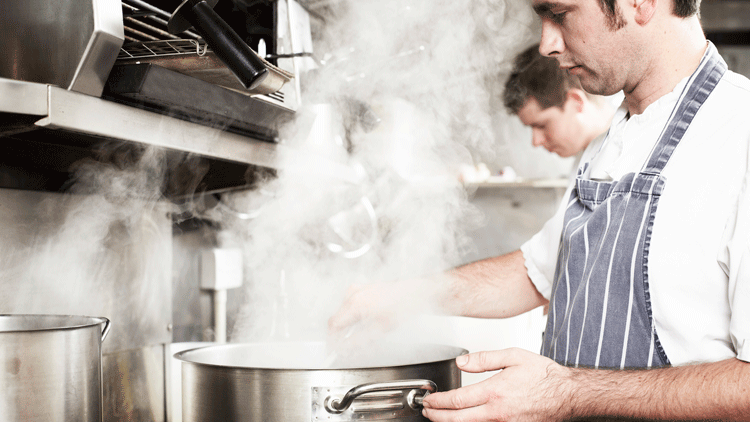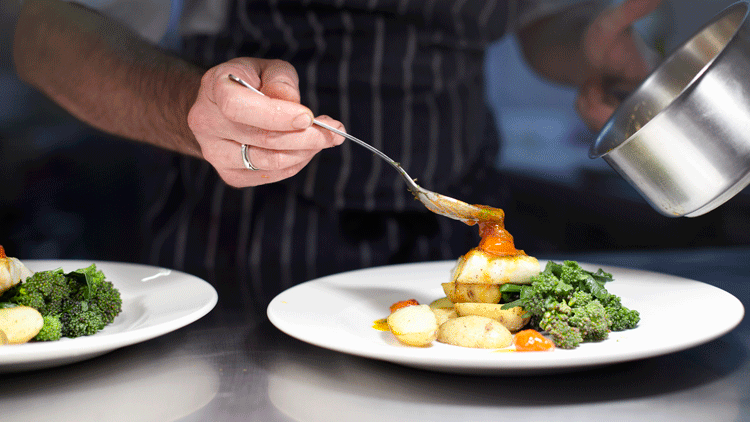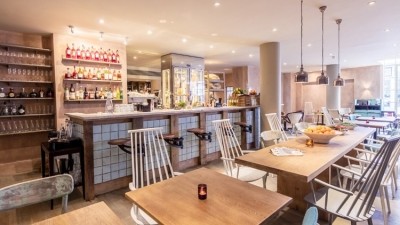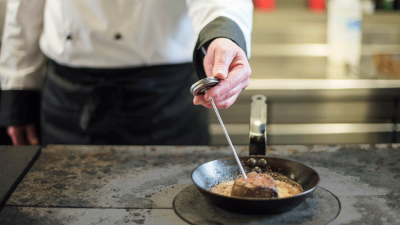sponsored by nisbets in place
How to kit out and manage your kitchen

As rates and rents increase, kitchens are getting smaller and smaller so making the most of the space is essential. A well-thought-out and functional kitchen will ensure chefs are happy – and a happy chef is a productive one.
With a low budget and an almost comically small space, Simon Whiteside had to exercise restraint when designing the kitchen at his recently opened Roe restaurant in Brixton.
“It’s about one third of a shipping container and can only really fit two people at any one time. The sink is opposite the six-burner. We joke that’s the ‘hot and wet’ section, because if you’re cooking on the six-burner you’re doing the washing up as well,” says Whiteside, who did most of the kitchen fit-out himself to save cash.
He didn’t retain any equipment from the space’s former occupant (it had taken too much of a hammering) but he did follow roughly the same footprint in order to use the same power and water connections, a decision that made the fit-out far quicker and less expensive.
“Through a twist of fate, I actually put the kitchen into that space in the first place (Whiteside was previously involved in Hook, another fish restaurant). It’s a well-designed space, even if I do say so myself,” he says.
Matching kit to menus
With so much kitchen equipment to choose from and so many decisions to make (do you go for gas or induction cookers, use multifunctional equipment or buy separate kit for each job?) the best place to start is by understanding the needs of your restaurant in terms of menu and number of covers.
Clearly, there is certain kit that will be part of most commercial kitchens, predominantly a combi-oven, deep-fat friers, a cooking range, warewashers and refrigeration and freezing equipment. Yet there are numerous things to consider when buying even these most obvious of items.
One common mistake when buying equipment is choosing something that won’t be powerful enough to meet your needs a few years down the line. This doesn’t mean you should be buying ovens or washers three times the size you require because they will be costly and increase your bills, but you should factor in potential growth. If you don’t, you’ll be left wanting during busy periods and could be forced to upgrade earlier than expected.
Calculating the size of kit you need will vary depending on its function. For example, for warewashers you should ensure the model reflects the amount of crockery or glasses that will need to be washed during your busiest period, while fridges should be capacious enough to easily hold sufficient stock – overloading will greatly hamper its efficiency and cause the fan to burn out prematurely.
Almost all commercial kitchens are arranged into sections run by one or more chefs, so head chefs need to think about the division of labour and create a menu that balances workload across the brigade and the space. This means thinking carefully about what kit goes into each section.
There’s no point in buying and maintaining equipment that’s not needed. Choosing equipment requires a solid operational understanding of kitchens, menu planning and kit, so the first time round most will want to employ specialists or, at the very least, ask suppliers for help.
“This isn’t my first rodeo. I know the pieces of equipment I’m going to be using. My key cooking equipment is a six-burner, a combi-oven and a waterbath,” says Whiteside, who sourced much of the kit for his new kitchen second hand.
There are two years left to run on his lease for Roe, so making a big investment in equipment designed to last for decades would have been a waste. “I have not gone for any premium kit. If I get two years of use out of the equipment I have opened with I’ll be very pleased indeed,” he continues. “The only thing that I won’t buy second hand are fridges. You never know the true history of a fridge so I always buy a new one. They’re on 24/7 and if they break down it can cost you a fortune in lost spoiled stock.”
Head chefs need to create a menu that balances workload across the brigade and the space
Purchasing options
There are numerous ways to purchase catering equipment, including finance. “We offer three different options that all allow the business to make these critical investments while allowing the equipment to effectively pay for itself as it is used,” says a spokesperson for leading equipment distributor Nisbets. “Our customers can choose from 0% finance, hire purchase and finance leasing, all of which allow the business to spread the cost of the equipment while keeping critical cash in the operation.”
Leasing is available across all of Nisbets heavy equipment ranges and gives the benefit of fixed, structured payments which can gain relief against corporation tax. Alternatively, 12 months 0% finance is a simple agreement available on a basket of goods totalling more than £500 and available across 20 or so eligible brands, with no additional fees or charges payable.
Equipment can, of course, also be purchased outright, and most suppliers will offer reconditioned equipment for those looking to cut costs. Isaac Bartlett-Copeland – chef-patron of Brighton restaurant Isaac At – was also on a tight budget when he spec’d his kitchen. “We made do without a lot of stuff.
Now the business has been going a while, we’ve been able to fill in the blanks a bit. In almost every case, we’ve instantly realised how much of a difference each piece of kit has made, not least our warewasher because we don’t employ a KP. Our biggest equipment purchase was a proper extraction system, which has improved the environment for the customers and the staff.”
The Isaac At kitchen is a stripped-back affair that has clearly been set up on a budget. Key pieces of equipment include a basic oven, waterbaths and portable induction stoves. At around £100 a pop, the latter have saved the business a fortune even if they do need to be replaced every now and then.
Bartlett-Copeland believes that those on a budget should generally go for simpler kit. “Cheap versions of complicated pieces of equipment don’t tend to last well in my experience. If it’s got a brain inside it, you’ll get constant error codes. There’s nothing more frustrating than being halfway through service and equipment breaking down.”
Preventative maintenance
The best way to ensure reliability is to treat your equipment well and get it serviced regularly. Alongside this, don’t underestimate the value of good aftercare and servicing. Heavy-duty equipment such as ovens and dishwashers are put through their paces on an hourly basis and are inevitably going to break down at some point – usually when you need them the most.
You should be safe in the knowledge that the brand you’ve bought has comprehensive after-sales support, including holding a good stock of spare parts and consumables (such as water filters) and can arrange ‘preventative planned maintenance’ service contracts on equipment. The last thing you need when your combi-oven packs up mid-service is to be put through to a call centre.
“Cleaning, de-scaling of water-using equipment and calibration of cooking equipment can increase the lifetime of the equipment,” says a Nisbets spokesperson. “Most equipment suppliers provide a maintenance schedule in their manuals. This may include daily, weekly and quarterly recommendations.”
Nisbets also recommends that kitchen managers should create their own task lists and ensure these are completed by their teams as required. Regularly cleaning and servicing heavy equipment such as ventilation units and extractor fans can also largely reduce energy consumption and utility costs.
As executive chef, Luke Tipping has seen numerous overhauls of Simpsons Restaurant in Birmingham. “Some 25 years ago, it was all begged, borrowed and stolen,” he says. “We’ve come a long way since then (Simpsons has held a star since 1994) and have made a considerable investment in the equipment in the kitchen, including three top-end combi-ovens. It’s like anything in life, if you buy well and look after it, you’ll end up with something that lasts. Our kitchen is on show to diners so I’m a stickler for keeping things clean and well-maintained.”
Much of the equipment in Tipping’s kitchen needs regular servicing and the restaurant has contracts with a number of suppliers and servicing companies. “Keeping on top of that is a job in itself, it’s one of the many things senior chefs have to do to keep everything running smoothly. It never stops, cooking is the small part of the job these days,” he says.
Induction cooking is up to 50% more efficient than traditional hobs
Energy efficiency
One of the biggest purchases for Simpsons was a top-of-the-line induction range. The restaurant was fairly early to the induction party. “It was about eight years ago,” says Tipping. “I thought it would take us a while to get used to it but it didn’t, the whole brigade took to it straight away and we haven’t looked back. It’s been a great investment. The environmental friendliness of the kit was a factor but, to be honest, it’s not the first thing we think about when we look at kit. It needs to be practical for what we’re doing with it and tough enough to get us through the day.”
Cooking is an energy-intensive undertaking. Restaurants and other food service operators use around 2.5 times more energy per square metre than other commercial businesses. Utilities typically account for between 2% and 6% of total sales. The cost could be reduced by upwards of 15% with some moderate changes to working practices.
Refrigeration and cooling is the single biggest user of energy in commercial kitchens, so restaurants should try and buy energy-efficient refrigeration (energy rating ‘A’) and carry out regular cleaning using products such as condenser cleaner
Induction cooking is up to 50% more efficient than traditional hobs because magnets are used to provide heat instead of elements. More energy is diverted directly into the food, and units also turn off automatically when pans are removed.
Kitchens are notorious energy users and the industry should be doing its bit for the environment by sourcing the most energy-efficient equipment it can. Being green isn’t high on most chefs’ list of priorities, but saving money should be – choosing energy-efficient kit means you can help save the environment as well as help your bank balance.













